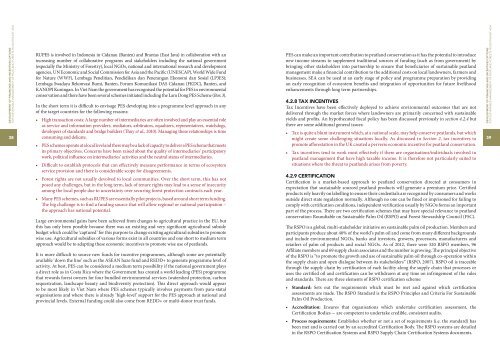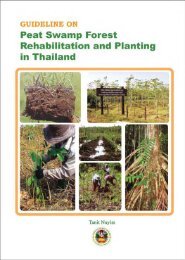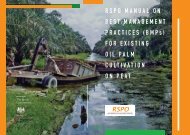Untitled - Peat Portal
Untitled - Peat Portal
Untitled - Peat Portal
You also want an ePaper? Increase the reach of your titles
YUMPU automatically turns print PDFs into web optimized ePapers that Google loves.
DEVELOPMENT OF FINANCING AND INCENTIVES OPTIONSFOR SUSTAINABLE MANAGEMENT OF PEATLAND FORESTS IN SOUTHEAST ASIA38RUPES is involved in Indonesia in Cidanau (Banten) and Brantas (East Java) in collaboration with anincreasing number of collaborative programs and stakeholders including the national government(especially the Ministry of Forestry), local NGOs, national and international research and developmentagencies, UN Economic and Social Commission for Asia and the Pacific (UNESCAP), World Wide Fundfor Nature (WWF), Lembaga Penelitian, Pendidikan dan Penerangan Ekonomi dan Sosial (LP3ES);Lembaga Swadaya Rekonvasi Bumi, Banten, Forum Komunikasi DAS Cidanau (FKDC), Banten, andKANOPI Kuningan. In Viet Nam the government has recognised the potential for PES in environmentalconservation and there have been several schemes initiated including the Lam Dong PES Scheme (Box 3).In the short term it is difficult to envisage PES developing into a programme level approach in anyof the target countries for the following reasons:• High transaction costs: A large number of intermediaries are often involved and play an essential roleas service and information providers, mediators, arbitrators, equalisers, representatives, watchdogs,developers of standards and bridge builders (Thuy et al., 2010). Managing these relationships is timeconsuming and delicate.• PES schemes operate at a local level and there may be a lack of capacity to deliver a PES scheme that meetsits primary objectives. Concerns have been raised about the quality of intermediaries’ participatorywork, political influence on intermediaries’ activities and the neutral status of intermediaries.• Difficult to establish protocols that can effectively measure performance in terms of ecosystemservice provision and there is considerable scope for disagreements.• Forest rights are not usually devolved to local communities. Over the short term, this has notposed any challenges, but in the long term, lack of tenure rights may lead to a sense of insecurityamong the local people due to uncertainty over securing forest protection contracts each year.• Many PES schemes, such as RUPES are essentially pilot projects, based around short term funding.The big challenge is to find a funding source that will allow regional or national participation –the approach has national potential.Large environmental gains have been achieved from changes to agricultural practice in the EU, butthis has only been possible because there was an existing and very significant agricultural subsidybudget which could be ‘captured’ for this purpose to change existing agricultural subsidies to promotewise use. Agricultural subsidies of various forms exist in all countries and one short to medium termapproach would be to adapting these economic incentives to promote wise use of peatlands.It is more difficult to source new funds for incentive programmes, although some are potentiallyavailable ‘down the line’ such as the ASEAN haze fund and REDD+ to generate programme level ofactivity. At best, PES can be considered a medium term possibility if the national government playsa direct role as in Costa Rica where the Government has created a world leading (PES) programmethat rewards forest owners for four bundled environmental services (watershed protection, carbonsequestration, landscape beauty and biodiversity protection). This direct approach would appearto be most likely in Viet Nam where PES schemes typically involves payments from para-statalorganisations and where there is already ‘high-level’ support for the PES approach at national andprovincial levels. External funding could also come from REDD+ or multi-donor trust funds.PES can make an important contribution to peatland conservation as it has the potential to introducenew income streams to supplement traditional sources of funding (such as from government) bybringing other stakeholders into partnership to ensure that beneficiaries of sustainable peatlandmanagement make a financial contribution to the additional costs on local landowners, farmers andbusinesses. SEA can be used at an early stage of policy and programme preparation by providingan early recognition of ecosystem benefits and integration of opportunities for future livelihoodenhancements through long term partnerships.4.2.8 TAX INCENTIVESTax Incentives have been effectively deployed to achieve environmental outcomes that are notdelivered through the market forces where landowners are primarily concerned with sustainableyields and profits. An hypothecated fiscal policy has been discussed previously in section 4.2.4 butthere are some additional general issues:• Tax is quite a blunt instrument which, at a national scale, may help conserve peatlands, but whichmight create some challenging situations locally. As discussed in Section 2, tax incentives topromote afforestation in the UK created a perverse economic incentive for peatland conservation.• Tax incentives tend to work most effectively if there are organisations/individuals involved inpeatland management that have high taxable income. It is therefore not particularly suited tosituations where the threat to peatlands arises from poverty.4.2.9 CERTIFICATIONCertification is a market-based approach to peatland conservation directed at consumers inexpectation that sustainably sourced peatland products will generate a premium price. Certifiedproducts rely heavily on labelling to ensure their credentials are recognised by consumers and worksoutside direct state regulation normally. Although no one can be fined or imprisoned for failing tocomply with certification conditions, independent verification usually by NGOs forms an importantpart of the process. There are two certification schemes that may have special relevance to peatlandconservation: Roundtable on Sustainable Palm Oil (RSPO) and Forest Stewardship Council (FSC).The RSPO is a global, multi-stakeholder initiative on sustainable palm oil production. Members andparticipants produce about 40% of the world’s palm oil and come from many different backgroundsand include environmental NGOs, banks and investors, growers, processors, manufacturers andretailers of palm oil products and social NGOs. As of 2012, there were 520 RSPO members, 96Affiliate members and 69 supply chain associates and the number is growing. The principal objectiveof the RSPO is “to promote the growth and use of sustainable palm oil through co-operation withinthe supply chain and open dialogue between its stakeholders” (RSPO, 2007). RSPO oil is traceablethrough the supply chain by certification of each facility along the supply chain that processes oruses the certified oil and certification can be withdrawn at any time on infringement of the rulesand standards. There are three elements of RSPO certification scheme:• Standard: Sets out the requirements which must be met and against which certificationassessments are made. The RSPO Standard is the RSPO Principles and Criteria For SustainablePalm Oil Production.• Accreditation: Ensures that organisations which undertake certification assessment, theCertification Bodies - are competent to undertake credible, consistent audits.DEVELOPMENT OF FINANCING AND INCENTIVES OPTIONSFOR SUSTAINABLE MANAGEMENT OF PEATLAND FORESTS IN SOUTHEAST ASIA39• Process requirements: Establishes whether or not a set of requirements (i.e. the standard) hasbeen met and is carried out by an accredited Certification Body. The RSPO systems are detailedin the RSPO Certification Systems and RSPO Supply Chain Certification Systems documents.





